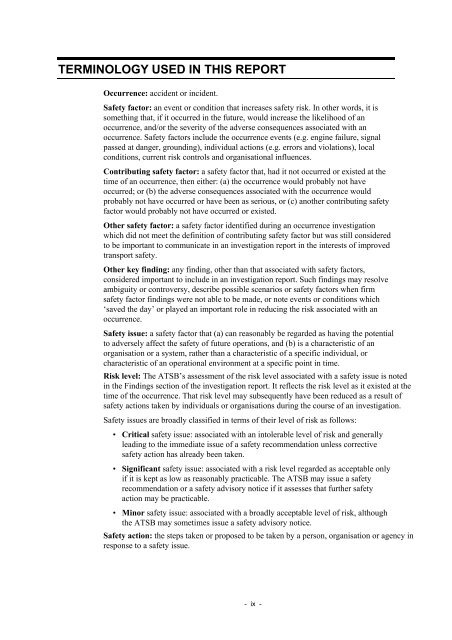Safety in the vicinity of non-towered aerodromes - Australian ...
Safety in the vicinity of non-towered aerodromes - Australian ...
Safety in the vicinity of non-towered aerodromes - Australian ...
Create successful ePaper yourself
Turn your PDF publications into a flip-book with our unique Google optimized e-Paper software.
TERMINOLOGY USED IN THIS REPORT<br />
Occurrence: accident or <strong>in</strong>cident.<br />
<strong>Safety</strong> factor: an event or condition that <strong>in</strong>creases safety risk. In o<strong>the</strong>r words, it is<br />
someth<strong>in</strong>g that, if it occurred <strong>in</strong> <strong>the</strong> future, would <strong>in</strong>crease <strong>the</strong> likelihood <strong>of</strong> an<br />
occurrence, and/or <strong>the</strong> severity <strong>of</strong> <strong>the</strong> adverse consequences associated with an<br />
occurrence. <strong>Safety</strong> factors <strong>in</strong>clude <strong>the</strong> occurrence events (e.g. eng<strong>in</strong>e failure, signal<br />
passed at danger, ground<strong>in</strong>g), <strong>in</strong>dividual actions (e.g. errors and violations), local<br />
conditions, current risk controls and organisational <strong>in</strong>fluences.<br />
Contribut<strong>in</strong>g safety factor: a safety factor that, had it not occurred or existed at <strong>the</strong><br />
time <strong>of</strong> an occurrence, <strong>the</strong>n ei<strong>the</strong>r: (a) <strong>the</strong> occurrence would probably not have<br />
occurred; or (b) <strong>the</strong> adverse consequences associated with <strong>the</strong> occurrence would<br />
probably not have occurred or have been as serious, or (c) ano<strong>the</strong>r contribut<strong>in</strong>g safety<br />
factor would probably not have occurred or existed.<br />
O<strong>the</strong>r safety factor: a safety factor identified dur<strong>in</strong>g an occurrence <strong>in</strong>vestigation<br />
which did not meet <strong>the</strong> def<strong>in</strong>ition <strong>of</strong> contribut<strong>in</strong>g safety factor but was still considered<br />
to be important to communicate <strong>in</strong> an <strong>in</strong>vestigation report <strong>in</strong> <strong>the</strong> <strong>in</strong>terests <strong>of</strong> improved<br />
transport safety.<br />
O<strong>the</strong>r key f<strong>in</strong>d<strong>in</strong>g: any f<strong>in</strong>d<strong>in</strong>g, o<strong>the</strong>r than that associated with safety factors,<br />
considered important to <strong>in</strong>clude <strong>in</strong> an <strong>in</strong>vestigation report. Such f<strong>in</strong>d<strong>in</strong>gs may resolve<br />
ambiguity or controversy, describe possible scenarios or safety factors when firm<br />
safety factor f<strong>in</strong>d<strong>in</strong>gs were not able to be made, or note events or conditions which<br />
‘saved <strong>the</strong> day’ or played an important role <strong>in</strong> reduc<strong>in</strong>g <strong>the</strong> risk associated with an<br />
occurrence.<br />
<strong>Safety</strong> issue: a safety factor that (a) can reasonably be regarded as hav<strong>in</strong>g <strong>the</strong> potential<br />
to adversely affect <strong>the</strong> safety <strong>of</strong> future operations, and (b) is a characteristic <strong>of</strong> an<br />
organisation or a system, ra<strong>the</strong>r than a characteristic <strong>of</strong> a specific <strong>in</strong>dividual, or<br />
characteristic <strong>of</strong> an operational environment at a specific po<strong>in</strong>t <strong>in</strong> time.<br />
Risk level: The ATSB’s assessment <strong>of</strong> <strong>the</strong> risk level associated with a safety issue is noted<br />
<strong>in</strong> <strong>the</strong> F<strong>in</strong>d<strong>in</strong>gs section <strong>of</strong> <strong>the</strong> <strong>in</strong>vestigation report. It reflects <strong>the</strong> risk level as it existed at <strong>the</strong><br />
time <strong>of</strong> <strong>the</strong> occurrence. That risk level may subsequently have been reduced as a result <strong>of</strong><br />
safety actions taken by <strong>in</strong>dividuals or organisations dur<strong>in</strong>g <strong>the</strong> course <strong>of</strong> an <strong>in</strong>vestigation.<br />
<strong>Safety</strong> issues are broadly classified <strong>in</strong> terms <strong>of</strong> <strong>the</strong>ir level <strong>of</strong> risk as follows:<br />
• Critical safety issue: associated with an <strong>in</strong>tolerable level <strong>of</strong> risk and generally<br />
lead<strong>in</strong>g to <strong>the</strong> immediate issue <strong>of</strong> a safety recommendation unless corrective<br />
safety action has already been taken.<br />
• Significant safety issue: associated with a risk level regarded as acceptable only<br />
if it is kept as low as reasonably practicable. The ATSB may issue a safety<br />
recommendation or a safety advisory notice if it assesses that fur<strong>the</strong>r safety<br />
action may be practicable.<br />
• M<strong>in</strong>or safety issue: associated with a broadly acceptable level <strong>of</strong> risk, although<br />
<strong>the</strong> ATSB may sometimes issue a safety advisory notice.<br />
<strong>Safety</strong> action: <strong>the</strong> steps taken or proposed to be taken by a person, organisation or agency <strong>in</strong><br />
response to a safety issue.<br />
- ix -
















